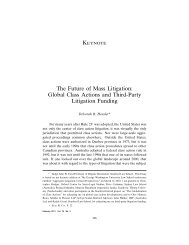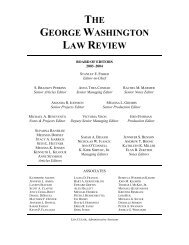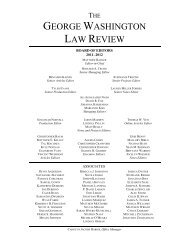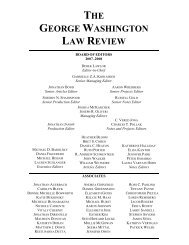View PDF - The George Washington Law Review
View PDF - The George Washington Law Review
View PDF - The George Washington Law Review
You also want an ePaper? Increase the reach of your titles
YUMPU automatically turns print PDFs into web optimized ePapers that Google loves.
894 <strong>The</strong> <strong>George</strong> <strong>Washington</strong> <strong>Law</strong> <strong>Review</strong> [Vol. 78:870<br />
B. Frank Michelman’s Analysis of Property, Utility, and Fairness<br />
Frank Michelman, in what is arguably the single most significant<br />
article on the subject, adopts a utilitarian approach to regulatory takings.<br />
124 He explains that redistributions of property due to collective<br />
action occur because they have been deemed efficient, or when “it has<br />
been determined that a change in the use of certain resources will<br />
increase the net payoff of goods . . . to society ‘as a whole.’” 125 However,<br />
according to Michelman, these redistributions are likely to be<br />
especially demoralizing to property owners. 126 Relying on the philosophy<br />
of Jeremy Bentham, Michelman explains that a “high level of productivity<br />
depends on arrangements which assure to every person who<br />
invests or labors that he will share in the fruits of his investment or<br />
labor to a predictable extent.” 127<br />
Michelman explains that the government must incur either demoralization<br />
or settlement costs, whichever is less, each time it redistributes<br />
property. 128 Demoralization costs are defined as<br />
the total of (1) the dollar [value] necessary to offset disutilities<br />
which accrue to losers and their sympathizers specifically<br />
from the realization that no compensation is offered, and (2)<br />
the present capitalized dollar value of lost future production<br />
(reflecting either impaired incentives or social unrest) caused<br />
by demoralization of uncompensated losers, their sympathizers,<br />
and other observers disturbed by the thought that they<br />
themselves may be subjected to similar treatment on some<br />
other occasion. 129<br />
Settlement costs, then, are “the dollar value of the time, effort,<br />
and resources which would be required in order to reach compensation<br />
settlements adequate to avoid demoralization costs.” 130 He further<br />
explains that certain rules of decision regarding regulatory<br />
takings may be understood by examining them through his theory. 131<br />
For instance, Michelman states that permanent physical occupations,<br />
which are per se takings under Loretto, are uniquely demoralizing and<br />
124 See Michelman, supra note 122, at 1214.<br />
125 Id. at 1173.<br />
126 See id. at 1210–11.<br />
127 Id. at 1211.<br />
128 See id. at 1215 (“When pursuit of efficiency gains entails capricious redistribution, either<br />
demoralization costs or settlement costs must be incurred.”).<br />
129 Id. at 1214.<br />
130 Id.<br />
131 See id. at 1224–45.









